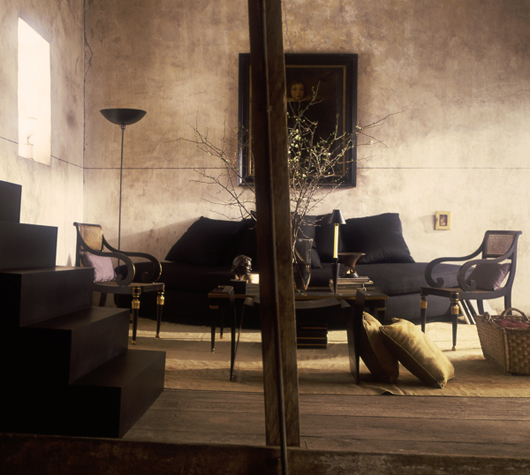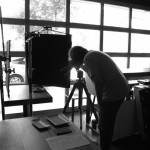Part II: Bruce Wolf, Photographer

[This is Part II of Sabina Samiee’s coverage on photographer Bruce Wolf, an adjunct instructor at the UO in Portland and instructor for Light and Color: Tools of the Trade Workshop for Summer in the City 2012. You can read Part I Bruce Wolf | A Little Profile on a Big Photographer posted previously.]

Now it is fall 2012. Wolf is firmly entrenched in the Portland scene. He is an adjunct instructor for the Summer in the City University of Oregon Portland program. And from the projects he has taken on, it is evident he has graciously assimilated the culture and vibe of Portland, and has never looked back. Granted he isn’t making the prodigious dollar amounts New York had bestowed upon him, but as he comments, “that really doesn’t matter.” Whether he is shooting Pietro Belluschi’s architectural wonders, a stunning plated concoction at Yakuza for a scrumptious-looking website, or photos for a children’s book on food, Wolf’s images are powerful, captivating, emotional, and have that je ne sais qua any photographer worth her salt dreams about. [See Bruce Wolf: A Little Profile on a Big Photographer]
If you are here in the city next summer, look him up: Summer in the City 2013—with a little luck and a fair wind, Wolf’s experience and knowledge will be back here again and yours for the taking at the UO in Portland. This is an opportunity to learn methods and process, gain knowledge and insight from one truly great photographer. And, as Wolf, himself puts it, he “[doesn’t] just want advanced photographers in [his] class,” not at all. In fact, he welcomes and encourages a specific kind of person, “Photographers at any level passionate about photography. . . .That’s what I’m looking for,” he states. It was a late afternoon, mid-summer and we were happily into our second coffee talk– “interview” – meeting at Floyd’s coffee shop in Old Town. Wolf was beginning to feel like an old friend. “Passionate about photography” and “photographers at any level:” this sounded mildly provocative…I was caught on the “at any level” phrase. It sounded so refreshing and open to possibility. I asked him to tell me more about his 2012 Summer in the City Light and Color workshop, the students he worked with, his expectations for the course and the students and his future plans.

Wolf finds that being welcoming to photographers of any level with a passion for picture-taking attracts students who are eager to learn and listen. And, photographers at any level can take insightful, thoughtfully composed images. Photographs should “say something about the person who took the photo, not just be an image of what that photographer captured.” In Wolf’s opinion, a photographer “needs to learn how to present the image so that it tells a story, leaves personal narrative and inhibitions behind, and freely exposes the photographer.” This ability can be learned over time with work and experimentation. Wolf aspired “to teach [his] students to tell us who they are, to expose their self.”

Wolf continued, speaking softly and thoughtfully. The intent of a photo is to translate a story and project a personal signature. When students presented their work to him for critique and review, Wolf found it best to refrain from criticism and rather try and find what “they thought the process was, or had been, like a personal journey” he says. Wolf wanted his students to learn how to use their photographs to “take us someplace” and to make their image a “personal reflection of what drives them to see what they see, and why they see it that way.” He suggested that they experiment with light, color, angle, cropping and content to express this.
Equally intriguing is Wolf’s unique pedagogical approach that assumes his students are blissfully “unaware of anything.” He continued, “I talk to them as if they know nothing.” Not intending to be at all demeaning or condescending, Wolf means he strives to instruct as if his students are a blank slate, ready and receptive to challenge the components of their work to access a sense of both the art and the science of photography. He finds this approach the least intimidating and the most encouraging to his students’ sense of free experimentation in the class.

There is one area, however, where Wolf expects his students to have a working knowledge. His Light and Color Workshop requested that students have an existing working familiarity with Photoshop, a technology Wolf feels “is essential to contemporary photography.” In addition, he only allowed the students to use their cameras in Manual mode—a somewhat daunting prospect for many. If a student needed help or instruction in the mode, Wolf gladly assisted. By using only Manual mode, Wolf encouraged each student “to regain control of the camera and the image.”
I asked Wolf his opinion on camera equipment. Would someone with a prosumer camera be as welcome as someone with a simple point-and-shoot? Wolf assured me, regarding equipment, students were not criticized for the quality or technical hierarchy of their equipment. One student was welcome to use her father’s point-and-shoot, which she did for the entire duration of the course. When asked if he felt the quality of one’s camera had a great deal to do with the quality of the image, Wolf responded that “it is not the camera that is the final instrument of the image” but how that “image is interpreted or taken forward to create an intention.” Here is where Photoshop becomes the somewhat indispensible tool of the contemporary photographer, the sine qua non that allows the artist | interpreter of the image to “sharpen the intention, to clarify and capture” what one has merged into pixels, and digitalized into a printable reality. Photoshop will help ease a transition from a captured moment to a fully finished image. Today’s digital photographs, says Wolf, will not be worked on in a traditional darkroom, a place where the photographer used to transition an image and produce desired effects, experimenting with light and dark, saturation and hue. Thus, says Wolf, “Today’s darkroom is Photoshop.”

With all his work, his reputation and his legacy, it is no wonder Wolf is carefully watched. Coming to Portland in 2009, a blog post by his then rep, Stockland Martel declared “BW MOVES TO PDX and POSTS photos.” [I would show you the post but Stockland Martel has since removed it.] It was a series of photos posted on Wolf’s online social media presence that precipitated a small tempest of curiosity—Wolf was doing something new, something different. Maybe Portland enabled Wolf to branch out into a new perspective, and explore that “loneliness” he talks about. Whatever it was, we can read about the “guerrilla photography” Wolf and his wife, Laurie launched into. Photographing over 70 Portland restaurants for Portland restaurant scene, Wolf found his way right into the delicious underbelly of some of Stumptown’s most coveted places.

As time has passed these last few years, Wolf has eased into a singular Portland aesthetic, appreciating and valuing a sense of independence, being in a league all his own, and valuing a certain obscurity for its own sake. He seems to have found meaning, and worth, and definitely his own Portland style of cool. He’s become one of us. He’s settled in with a new rep, Greenhouse, and released a new book, along with collaborator and wife Laurie Wolf, Portland, Oregon Chef’s Table .

Things are looking bright and beautiful for this New York transplant. As evidence to his understanding of things Portland, whether due to the cagey arrangements of representatives or Wolf’s own propensity to find meaningful working relationships, halibut-sized printed monthly publications have been scooping him up and sending him back out to hone his forte with a uniquely Portland grind. And, now that we can open up some of our favorite regionally-based magazines and see architecture from our own metropolitan backyard photographed by Wolf; get google-guided to a unique Portland restaurant and stumble upon images from a few of those places we head to for something uniquely delicious, we see Wolf’s light and color in new places. Take a trip to our favorite bookstores and see Wolf’s images in lovely volumes available to grace our coffee tables and our kitchen bookshelves. We can access Wolf’s Portland work almost daily and we can even take a university summer course from him. When asked what his plans for future courses at UO might be and if he’s interested in teaching again, Wolf responded, pointblank, “I’d love to.” In fact, he is interested in teaching photography at all levels, lower and upper division, beginners to advanced. In any case, Portland and, indeed, Oregon is certainly richer and even more beautiful when we have Wolf’s imagery of our environment surrounding us—all in gorgeous light and color…. Let’s hope it stays that way, because he sure makes things look good.
[As if it were not readily obvious, black and white photographs in this post –devoid of color and not much in the way of brilliant lighting, were taken by the author, who somewhat reluctantly posts her images in the same blog as BW images. Images from Wolf were taken from his blog, and website, and provided to the author.]
ABOUT SUMMER IN THE CITY
In addition to photographer Bruce Wolf, Summer In the City has offered the teachings of academic and creative phenomena such as D’Wayne Edwards, James Cutler who directs the Summer Portland Architecture Program, and Bill Tripp, among others. It is an eclectic arts and architecture-based program, offering interdisciplinary courses, specialized studios, and a lower-division, requirement-satisfying class in cooperation with the new Urban Ducks program. In a come-one-come-all egalatarian manner, the UO opens its doors and lets the summer breeze in as Summer in the City welcomes both enrolled UO students, community members in the Academic Extension program and professionals seeking to enhance and expand their professional affiliation, network and expertise. Above all, it is an opportunity to learn from experts. Come join us next summer!




